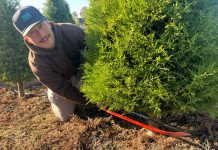Russell Jordan survived Arctic military plane crash 55 years
ago
Russell Jordan collected volumes of memories over his 86 years,
but none of them so vivid as those of a dark, Arctic winter’s day
55 years ago.
Russell Jordan survived Arctic military plane crash 55 years ago
Russell Jordan collected volumes of memories over his 86 years, but none of them so vivid as those of a dark, Arctic winter’s day 55 years ago.
That was the day his life was spared while crash-landing during a military mission over the Arctic Circle in 1947.
As he goes back in time to reflect on the story, one can see the stirring of emotions. Expressions change on his face as he talks about the event from his apartment at Wheeler Manor in Gilroy.
With one hand on an old scrapbook and another clutching a still unopened pack of Charms candies from that flight, Jordan remembers the day vividly.
“I think about it when I wake up and go to bed, every day,” said Jordan. “I never forget it because I shouldn’t be here. I got out by the skin of my teeth.”
A pilot with the U.S. Air Force during the start of the Cold War, Jordan was one of the first members of the Strategic Air Command’s 46th Reconnaissance Squadron that was commissioned to routinely fly B-29s from Fairbanks, Alaska to the North Pole and back in search of land masses that could be used by the Soviet Union to launch a nuclear strike on the United States from the Western Hemisphere.
The operation was called Project Nanook.
“It was so top secret that no one knew what we were doing until 1987,” Jordan said. “Not even my wife knew what I was doing. We had the A Bomb and the Germans had the first rockets. We knew that it was just a matter of time before the Russians got all the secrets to both. If land was above Alaska, we knew that they could aim at Alaska and slowly take over.”
At the time, Jordan had been in the military for six years. He was first drafted into the service in February 1941 and was stationed in the Coast Artillery at Fort Scott near the south end of the Golden Gate Bridge, which is now part of the Presidio.
In March 1946, he went to Nebraska to train as a pilot for the top-secret program. One month later, he was assigned to his post at Ladd Field in Fairbanks.
In all, the military used 19 12-man crews to make the pioneering flights to the North Pole and back.
The planes, formerly used for bombing runs during World War II, were gutted and the bomb bay racks and gun turrets were removed. The fuselage was packed with 14 640-gallon tanks to accommodate the 20-plus-hour flights that were required to circumnavigate the earth’s polar region.
In addition to the massive array of fuel tanks, cameras were mounted below the planes to intermittently photograph the topography, which assisted the military in mapping the territory.
Prior to his fateful mission, Jordan piloted two other flights that explored the region.
On February 22, 1947, Jordan was the co-pilot on the flight that changed his life.
“Nobody knew nothing about polar navigation, nothing,” said Jordan. “When you’re at the North Pole every direction on your compass is south. Compasses were useless once you got above the artic circle.”
All of the flights were made at night for both military reasons and in order for navigators to track their plane’s direction by the positioning of the stars.
Tracking the stars isn’t a problem as long as the sky is clear.
“When we got to the Pole everything was fine that night,” said Jordan. “But on the way back, we hit cloud cover and had trouble astro-navigating on a three-star fix. We broke out of the clouds at 24,000 feet.”
But the navigator made a mistake and told the crew to hold their heading towards the sun.
“Eventually, we knew we were lost and we didn’t know the direction we were heading,” said Jordan.
With just minutes of fuel left – the number three engine had sputtered on a banked turn – the crew descended to find a spot where they could attempt to land.
At the last second, the crew radioed for help.
“We knew we were in trouble and we broke radio silence,” said Jordan. “We weren’t supposed to radio because the Russians could get a fix on you.”
By then, Jordan’s plane, the Kee Bird, had been up for 19 hours and 40 minutes. With the Alaska base nowhere in sight, suddenly Jordan spotted “three enormous ice islands.”
“One was 25 miles in diameter and had a 75-foot high wall of ice on it,” said Jordan, looking as if he was recalling events of only a few hours ago. “We windmilled the props to suck the gas out, kept the landing gear up because we didn’t know what was under the snow and ice and opened the windows in case the plane caught fire and we had to jump out. We knew we had a chance if it didn’t break up.”
It didn’t.
Seconds later the Kee Bird landed intact on a frozen lake and skidded gradually onto land.
Ironically, his wife, Betty, was in Nebraska with her parents and knew something was wrong.
“I was living with my mom and dad and had gone to the movies but I didn’t feel right and left,” said his wife of 61 years. “A neighbor of ours had a radio and I asked him if he had heard anything about a plane going down. He said, ‘yes, one went down in Alaska.’ I knew right away it was my husband.”
Although they didn’t know it at the time, the crew had landed on the northwestern tip of Greenland-600 miles from the North Pole and some 1,500 miles off course.
“When we first landed there was a great deal of steam and mist. I thought it was smoke from the plane and was ready to jump out. It was the snow melting on the engines,” said Jordan with a smile. “We all made it. I dropped to my knees and some of the other guys did the same. Somebody was watching over us that night.”
Although they had made it, Jordan and his peers were far from safe. The temperature that evening was 47 degrees below zero.
“We were taught during survival training not to sleep in the fuselage and not to wear clothes in the sleeping bag,” said Jordan. “So here I am in my BVD’s outside and it’s 47 below as I’m trying to get into the sleeping bag. I hadn’t slept in so long though, I didn’t even care and went right out.”
Two days later, the Kee Bird was located and food was dropped to the crew. On the third day, Jordan and the 10 other members of the crew were rescued and flown to a military base in Holyoke, Mass.
After the flight, Jordan went up one more time and stayed on active duty four more months before signing up for the reserves.
From 1950 to 1984 Jordan was an insurance agent for Allstate. He and his wife have three children and 10 grand- and great-grandchildren.
After retiring in 1984 from Allstate Insurance, he and his wife traveled via motor home throughout the country and settled in Gilroy six years ago for its ideal climate.
While Jordan has many fond memories of his life, he will never forget that night in the sky.
After his rescue, the Kee Bird stayed behind, intact on the shallow lakebed for more than 50 years.
In the early 1990s, the plane was restored on site in preparation for a flight to Washington, D.C., where it was to be placed in the Smithsonian Institute for public display. But an electrical fire broke out when the plane was about to take off.
Today all that remains are the plane’s tail section and wings.
As the Kee Bird has suffered over the years, the 11-man crew has also dwindled. Only five remain. Russell Jordan is one of them.









